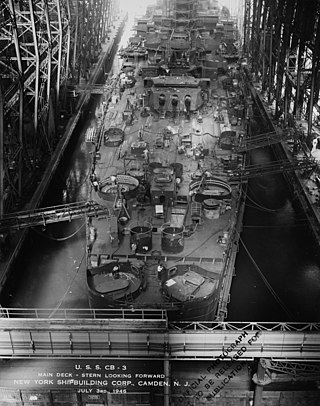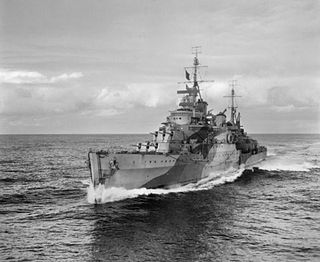
The Montana-class battleships were planned as successors of the Iowa class for the United States Navy, to be slower but larger, better armored, and with superior firepower. Five were approved for construction during World War II, but changes in wartime building priorities resulted in their cancellation in favor of continuing production of Essex-class aircraft carriers and Iowa-class battleships before any Montana-class keels were laid.

The heavy cruiser was a type of cruiser, a naval warship designed for long range and high speed, armed generally with naval guns of roughly 203 mm (8 inches) in calibre, whose design parameters were dictated by the Washington Naval Treaty of 1922 and the London Naval Treaty of 1930. The heavy cruiser is part of a lineage of ship design from 1915 through the early 1950s, although the term "heavy cruiser" only came into formal use in 1930. The heavy cruiser's immediate precursors were the light cruiser designs of the 1900s and 1910s, rather than the armoured cruisers of the years before 1905. When the armoured cruiser was supplanted by the battlecruiser, an intermediate ship type between this and the light cruiser was found to be needed—one larger and more powerful than the light cruisers of a potential enemy but not as large and expensive as the battlecruiser so as to be built in sufficient numbers to protect merchant ships and serve in a number of combat theatres.

The Pensacola class was a class of United States Navy heavy cruiser, the first "treaty cruisers" designed under the limitations set by the Washington Naval Treaty, which limited cruisers to a maximum of 10,000 long tons (10,160 t) displacement and a maximum main battery caliber of 8-inch (203 mm).

USS Hawaii (CB-3) was intended to be the third member of the Alaska-class large cruisers. It was the first United States Navy ship to be named after the then-Territory of Hawaii. Because Hawaii's construction was delayed by higher-priority ships like aircraft carriers, her keel was not laid until December 1943, about two years after her sister ship Guam.

The Alaska class were six very large cruisers ordered before World War II for the United States Navy, of which only two were completed and saw service late in the war. The US Navy designation for the ships of this class was 'large cruiser' (CB) and the majority of leading reference works consider them as such. However, various other works have alternately described these ships as battlecruisers despite the US Navy having never classified them as such. The Alaskas were all named after territories or insular areas of the United States, signifying their intermediate status between larger battleships and smaller heavy and light cruisers.

HMS Courageous was the lead ship of her class of three battlecruisers built for the Royal Navy in the First World War. Designed to support the Baltic Project championed by First Sea Lord John Fisher, the ship was very lightly armoured and armed with only a few heavy guns. Courageous was completed in late 1916 and spent the war patrolling the North Sea. She participated in the Second Battle of Heligoland Bight in November 1917 and was present when the German High Seas Fleet surrendered a year later.

The Tiger class were a class of three British warships of the 20th century and the last all-gun cruisers of the Royal Navy. Construction of three Minotaur-class cruisers began during World War II but, due to post-war austerity, the Korean War and focus on the Royal Air Force over the surface fleet, the hulls remained unfinished. Against a background of changing priorities and financial constraints, approval to complete them to a modified design was given in November 1954 and the three ships – Tiger, Lion and Blake – entered service from March 1959.

The Town class consisted of 10 light cruisers built for the Royal Navy during the 1930s. The Towns were designed to the constraints imposed by the London Naval Treaty of 1930. The ships were built in three distinct sub-classes, the Southampton, Gloucester and Edinburgh classes respectively, each sub-class adding on further weaponry.

The County class was a class of heavy cruisers built for the Royal Navy in the years between the First and Second World Wars. They were the first post-war cruisers constructed for the Royal Navy and were designed within the limits of the Washington Naval Treaty of 1922. Such ships, with a limit of 10,000 tons, standard displacement and 8-inch calibre main guns may be referred to as "treaty cruisers".

The Hawkins class consisted of five heavy cruisers built for the Royal Navy during the First World War, although none of them saw service during the war. The first ship to be completed, HMS Vindictive, was renamed from HMS Cavendish and converted into an aircraft carrier while under construction. All ships were named after Elizabethan sea captains. The three ships remaining as cruisers in 1939 served in the Second World War, with Effingham being an early war loss through wreck; Raleigh had been lost in a similar shipwreck on uncharted rocks in 1922. Vindictive, though no longer a cruiser, also served throughout the War. This class formed the basis for the definition of the maximum cruiser type under the Washington Naval Treaty of 1922.

HMS Vindictive was a warship built during the First World War for the Royal Navy (RN). Originally designed as a Hawkins-class heavy cruiser and laid down under the name Cavendish, she was converted into an aircraft carrier while still being built. Renamed in 1918, she was completed a few weeks before the end of the war and saw no active service with the Grand Fleet. The following year she participated in the British campaign in the Baltic against the Bolsheviks, during which her aircraft made numerous attacks against the naval base at Kronstadt. Vindictive returned home at the end of the year and was placed in reserve for several years before her flight decks were removed and she was reconverted back into a cruiser. The ship retained her aircraft hangar and conducted trials with an aircraft catapult before she was sent to the China Station in 1926. A year after her return in 1928, she was again placed in reserve.

Seydlitz was a heavy cruiser of Nazi Germany's Kriegsmarine, fourth in the Admiral Hipper class, but was never completed. The ship was laid down in December 1936 and launched in January 1939, but the outbreak of World War II slowed her construction and fitting-out work was finally stopped in the summer of 1940 when she was approximately 95 percent complete. The unfinished ship remained pier-side in the shipyard until March 1942, when the Kriegsmarine decided to pursue aircraft carriers over surface combatants. Seydlitz was among the vessels chosen for conversion into auxiliary aircraft carriers.

The Normandie class consisted of five dreadnought battleships ordered for the French Navy in 1912–1913. It comprised Normandie, the lead ship, Flandre, Gascogne, Languedoc, and Béarn. The design incorporated a radical arrangement for the twelve 340 mm (13.4 in) main battery guns: three quadruple-gun turrets, the first of their kind, as opposed to the twin-gun turrets used by most other navies. The first four ships were also equipped with an unusual hybrid propulsion system that used both steam turbines and triple-expansion steam engines to increase fuel efficiency.

The Japanese cruiser Ibuki (伊吹) was a heavy cruiser built for the Imperial Japanese Navy (IJN) during World War II. The lead ship of her class of two ships, she was ordered to be converted into a light aircraft carrier in 1943 before completion to help replace the aircraft carriers sunk during the Battle of Midway in mid-1942. The conversion was delayed and finally stopped in March 1945 in order to concentrate on building small submarines. Ibuki was scrapped in the Sasebo Naval Arsenal beginning in 1946.
The two Tone-class cruisers were the last heavy cruisers completed for the Imperial Japanese Navy. The Tone-class cruisers were originally envisaged as the 5th and 6th vessels in the Mogami class. However, by the time construction began, serious weaknesses in the Mogami-class hull design had become clear following the Fourth Fleet incident in 1935. As Japan no longer was obligated to abide by the limitations of the London Naval Treaty, a new design was created and new means of construction were utilized. Although the external dimensions were close to the Mogami class, the design was quite different, with all the main battery of guns placed forward of the bridge, reserving the entire stern area as a large seaplane operations deck. Unlike the U.S. Navy, the Japanese did not have a dual role attack/scout aircraft, nor did they assign any of their carrier aircraft to a reconnaissance role. Little emphasis was placed on this aspect of carrier warfare. Instead the Japanese reserved all of their carrier aircraft for attack roles. Reconnaissance then was relegated to the float planes carried by cruisers. The Tone and the Chikuma were intended to provide the long range reconnaissance needed for Japan's carrier Air Fleets.

The aircraft cruiser is a warship that combines the features of the aircraft carrier and a surface warship such as a cruiser or battleship.

The Amagi class was a series of four battlecruisers planned for the Imperial Japanese Navy (IJN) as part of the Eight-eight fleet in the early 1920s. The ships were to be named Amagi, Akagi, Atago, and Takao. The Amagi design was essentially a lengthened version of the Tosa-class battleship, but with a thinner armored belt and deck, a more powerful propulsion system, and a modified secondary armament arrangement. They were to have carried the same main battery of ten 41 cm (16.1 in) guns and been capable of a top speed of 30 knots.

The Lexington-class battlecruisers were officially the only class of battlecruiser to ever be ordered by the United States Navy. While these six vessels were requested in 1911 as a reaction to the building by Japan of the Kongō class, the potential use for them in the U.S. Navy came from a series of studies by the Naval War College which stretched over several years and predated the existence of the first battlecruiser, HMS Invincible. The fact they were not approved by Congress at the time of their initial request was due to political, not military considerations.
The Neptune class was a proposed class of cruisers planned for the British Royal Navy in the latter years of the Second World War. They were large ships which were to be armed with twelve 6-inch (152 mm) dual-purpose guns and with a heavy secondary armament. Although five ships of the class were planned in 1944, they were cancelled following the end of the war and before construction could begin.
The Minotaur class, or Design Z, was a proposed class of light cruisers planned for the British Royal Navy shortly after the Second World War. Design Z had several proposed configurations with differing armament and propulsion arrangements. The designs were large ships that were planned to be armed with ten 6 in (152 mm) dual purpose guns and an extensive array of 3 in (76 mm) secondary guns. Six ships of the class were planned in 1947 but they were ultimately cancelled before construction could begin, owing to the post-war economic difficulties of the United Kingdom and shifting naval priorities.

















